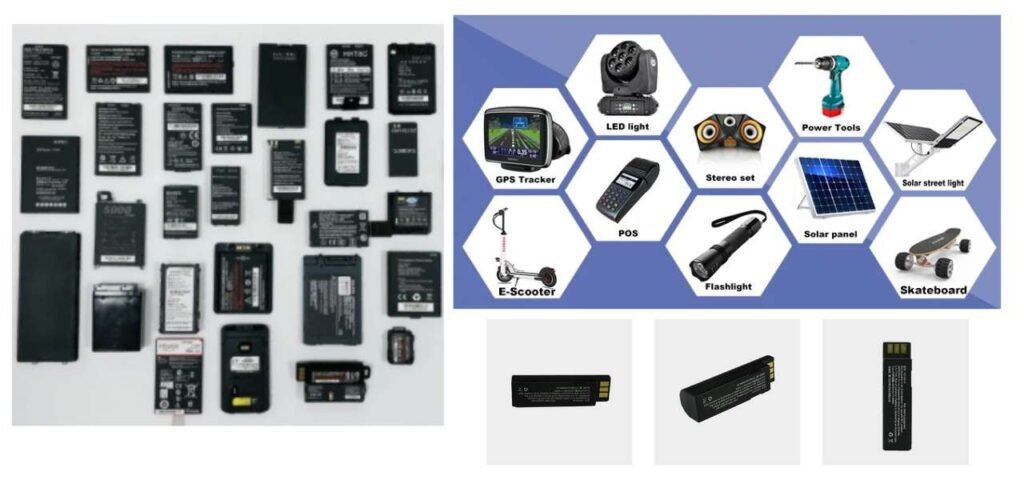Baterías de polímero de litio (LiPo) son fundamentales para alimentar dispositivos de alto rendimiento como drones, coches teledirigidos, bicicletas eléctricas y mucho más. Sin embargo, cargar correctamente estas baterías es esencial para garantizar su longevidad, seguridad y rendimiento óptimo. En este artículo, profundizaremos en Cargadores de baterías LiPoy cómo elegir el cargador que mejor se adapte a sus necesidades. Tanto si eres principiante como experto, en esta completa guía encontrarás todo lo que necesitas saber.

¿Qué son las baterías de polímero de litio y por qué necesitan cargadores especiales?
Las baterías de polímero de litio (LiPo) son baterías ligeras de alta densidad energética que suelen utilizarse en aplicaciones que requieren fuentes de energía potentes y compactas. A diferencia de otros tipos de baterías, como las de níquel-hidruro metálico (NiMH) o las de plomo-ácido, las baterías LiPo tienen unos requisitos de carga únicos.
Las baterías LiPo están formadas por celdas individuales, cada una con una tensión nominal de 3.7V y una tensión máxima de 4,2 V con carga completa. La sobrecarga o infracarga de una batería LiPo puede provocar riesgos de seguridad como sobrecalentamiento, hinchazón o incluso incendios. Por ello, los especialistas Cargadores de baterías LiPo están diseñados para regular la tensión, equilibrar las células y optimizar el rendimiento de la carga.
Características principales de los cargadores de baterías LiPo
Un cargador LiPo de alta calidad debe realizar varias tareas críticas:
- Carga de saldo: Garantiza que todas las celdas de un pack multicelda se carguen uniformemente para evitar la sobrecarga o la carga insuficiente.
- Regulación de tensión: Mantiene la tensión dentro de los límites de seguridad (3,7 V a 4,2 V por célula).
- Modos de carga: Ofrece distintos modos, como carga rápida, carga equilibrada y carga de almacenamiento, para satisfacer distintas necesidades.
Si utiliza un cargador específico, no sólo protegerá su batería, sino que también prolongará su vida útil, garantizando la máxima utilidad para sus dispositivos.
Cómo elegir el mejor cargador de baterías de polímero de litio
Seleccionar el cargador adecuado para sus baterías LiPo depende de varios factores, como las especificaciones de la batería, el uso previsto y el presupuesto. Aquí tienes un desglose detallado de lo que debes tener en cuenta:
1. Compatibilidad del número de elementos de la batería
Las baterías LiPo están disponibles en configuraciones como 1S (3,7V), 2S (7,4V), 3S (11,1V)y más. El cargador debe ser compatible con el número específico de celdas de la batería.
Por ejemplo, si utiliza un Batería LiPo 3SAsegúrese de que el cargador es compatible con configuraciones de 3S. Muchos cargadores modernos admiten una amplia gama de recuentos de células, normalmente de 1S a 6S o incluso más.
2. Corriente de carga y potencia de salida
La corriente de carga, medida en amperios (A), determina la velocidad de carga de la batería. La velocidad de carga ideal para una batería LiPo suele ser 1Cdonde C es la capacidad de la batería en amperios-hora (Ah). Por ejemplo:
- Una batería de 2200mAh (2.2Ah) debe cargarse a 2.2A para una carga segura y eficaz.
La potencia de salida del cargador, medida en vatios (W), es otro factor crítico. Para calcular la potencia en vatios necesaria, multiplique el voltaje de la batería por la corriente de carga. Por ejemplo:
- Cargar una LiPo 3S (11,1V) a 2,2A requiere un cargador con al menos 24.4W (11,1 V x 2,2 A).
3. Modos de carga
Los mejores cargadores LiPo ofrecen múltiples modos de carga para adaptarse a las diferentes necesidades:
- Carga de equilibrio: Equilibra las células individuales para garantizar niveles de tensión uniformes.
- Carga de almacenamiento: Lleva la batería a un voltaje de almacenamiento seguro (normalmente 3,8 V por celda) para evitar la degradación durante el almacenamiento a largo plazo.
- Carga rápida: Acelera el proceso de carga, aunque puede omitir el equilibrado.
- Modo de descarga: Reduce de forma segura el voltaje de la batería si es demasiado alto para el almacenamiento.
4. Seguridad
La seguridad debe ser una prioridad a la hora de elegir un cargador LiPo. Busque características tales como:
- Protección contra sobrecarga: Evita que las células superen los 4,2 V.
- Control de la temperatura: Te avisa si la batería o el cargador se sobrecalientan.
- Protección contra cortocircuitos: Evita daños en caso de problemas de cableado.
5. Reputación y calidad de la marca
Invertir en un cargador fiable de un fabricante reputado es crucial. Guangdong Yungbang New Energy Co., Ltd., por ejemplo, es una fuente de confianza para... baterías de polímero de litio personalizadas y cargadores, conocidos por su alta calidad y su excepcional servicio de atención al cliente.
La ciencia de la carga de equilibrio
La carga de equilibrio es una de las funciones más importantes de un cargador LiPo, especialmente para baterías multicelda. He aquí por qué es importante:
Cada celda de una batería LiPo tiene una resistencia interna ligeramente diferente, lo que puede provocar que algunas celdas terminen de cargarse antes que otras. Sin una carga equilibrada, la sobrecarga de una célula y la subcarga de otra pueden provocar:
- Sobrecalentamiento: Las células sobrecargadas son más propensas al desbordamiento térmico.
- Reducción de la vida útil: Los voltajes desiguales de las celdas degradan el rendimiento de la batería con el tiempo.
- Riesgos para la seguridad: Hinchazón, fugas o incluso incendios.
Un cargador de equilibrio controla el voltaje de cada celda individual y ajusta la velocidad de carga para garantizar que todas las celdas alcancen exactamente los 4,2 V. Esto no sólo maximiza la vida útil de la batería, sino que también garantiza un funcionamiento seguro.
Cómo cargar las baterías LiPo de forma segura
La carga de baterías LiPo requiere un estricto cumplimiento de los protocolos de seguridad. He aquí una guía paso a paso para garantizar una carga segura y eficiente:
Paso 1: Utilice una bolsa de carga ignífuga
Coloque siempre la batería en un Bolsa LiPo ignífuga durante la carga. Esto minimiza el riesgo de propagación del fuego en caso de sobrecalentamiento o avería.
Paso 2: Configurar el cargador
Ajusta tu cargador a la configuración adecuada:
- Tipo de batería: Selecciona el modo "LiPo".
- Recuento de células: Confirme que el cargador detecta el número correcto de células.
- Tasa de carga: Ajuste la corriente de carga a 1C a menos que la batería especifique lo contrario.
Paso 3: Supervisar el proceso
Nunca deje una batería LiPo desatendida mientras se carga. Compruebe periódicamente las lecturas de tensión y corriente de la pantalla del cargador, y palpe la batería para detectar signos de sobrecalentamiento.
Paso 4: Utilizar el modo de carga de equilibrio
Utilice siempre la carga equilibrada para las baterías multicelda para garantizar que cada celda se carga de manera uniforme.
Paso 5: Cargar en un lugar fresco y seco
Evite cargar las baterías LiPo bajo la luz directa del sol, cerca de materiales inflamables o en entornos de alta humedad.

Los mejores cargadores de baterías de polímero de litio
Si estás listo para invertir en un cargador de alta calidad, aquí tienes algunas recomendaciones:
- ISDT Q6 Pro
- Tamaño compacto, 300W de potencia de salida, soporta baterías 1-6S.
- Ideal para entusiastas del RC que necesitan portabilidad.
- SkyRC iMAX B6AC V2
- Compatibilidad con CA/CC, carga equilibrada y una interfaz intuitiva.
- Ideal para principiantes y aficionados.
- Hitec RDX1 Pro
- Soporta hasta 6S, 100W de potencia y modo de almacenamiento.
- Perfecto para uso doméstico.
- ToolkitRC M6D
- Carga de doble canal, salida de 500 W y funciones avanzadas de supervisión.
- Diseñado para usuarios avanzados.
- Venom Pro Duo
- Carga dos baterías simultáneamente, 80 W por canal.
- Ideal para usuarios con varias baterías.
¿Por qué elegir Guangdong Yungbang New Energy Co.
En Guangdong Yungbang New Energy Co., Ltd., nos enorgullecemos de ser un fábrica de origen para baterías LiPo y Baterías 18650. Nuestros productos se pueden personalizar para satisfacer sus necesidades específicas, y nos comprometemos a ofrecer un servicio de atención al cliente de primera categoría. Tanto si necesita una batería de alto rendimiento como un cargador fiable, tenemos las soluciones para alimentar sus dispositivos de forma segura y eficiente.
Conclusión
Los cargadores de baterías de polímero de litio son esenciales para mantener con seguridad el rendimiento y la vida útil de sus baterías LiPo. Si conoces sus características, eliges el modelo adecuado y sigues unas prácticas de carga correctas, podrás maximizar la utilidad de tus baterías al tiempo que garantizas la seguridad.
Si busca soluciones personalizadas de alta calidad, piense en trabajar con Guangdong Yungbang New Energy Co. Estamos especializados en ofrecer baterías de polímero de litio personalizadas y accesorios adaptados a sus necesidades.
PREGUNTAS FRECUENTES
1. ¿Cuánto tarda en cargarse una batería LiPo?
El tiempo de carga depende de la capacidad de la batería y de la velocidad de carga. Por ejemplo, una batería de 2200mAh cargada a 1C (2,2A) tardará aproximadamente una hora.
2. ¿Puedo utilizar un cargador normal para baterías LiPo?
No, sólo deben utilizarse cargadores LiPo especializados para evitar sobrecargas, subcargas o riesgos para la seguridad.
3. ¿Qué ocurre si se sobrecarga una batería LiPo?
La sobrecarga puede hacer que la batería se hinche, se sobrecaliente o incluso se incendie. Vigile siempre su cargador y utilice los ajustes correctos.
4. ¿Cómo debo guardar las baterías LiPo?
Guarde las baterías LiPo a su voltaje de almacenamiento (3,8 V por celda) en un lugar fresco y seco. Utilice una bolsa ignífuga LiPo para mayor seguridad.
5. ¿Puede Guangdong Yungbang New Energy Co. personalizar los cargadores de baterías?
Sí, ofrecemos soluciones personalizadas para satisfacer sus requisitos específicos. Póngase en contacto con nosotros para obtener más información sobre nuestros productos y servicios.

